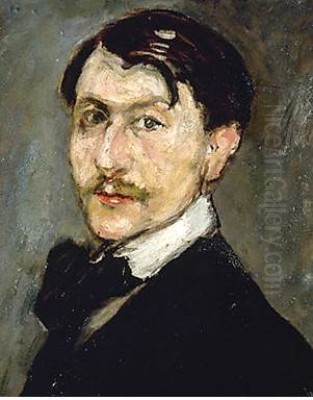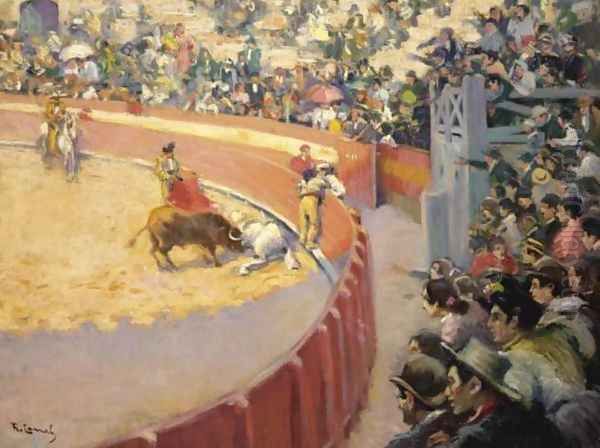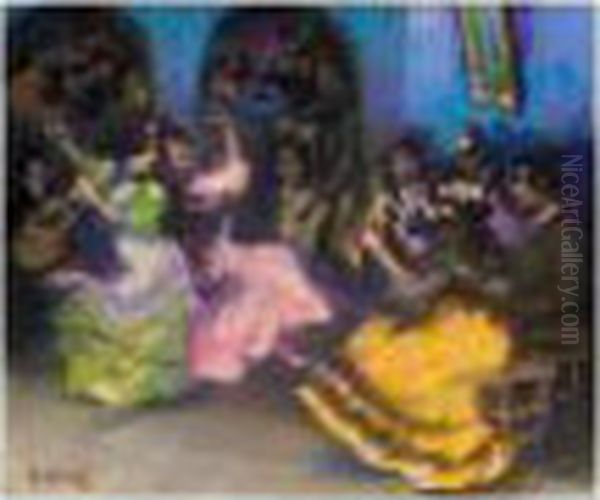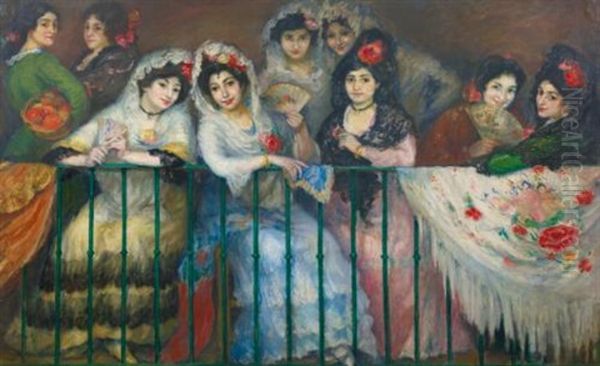
Ricardo Canals y Llambí (1876-1931) stands as a significant, albeit sometimes overlooked, figure in the vibrant tapestry of Spanish and Catalan art at the turn of the 20th century. Born in Barcelona, a city then burgeoning as a nucleus of artistic innovation, Canals y Llambí navigated the dynamic currents of Modernisme, Impressionism, and Post-Impressionism, forging a distinctive style that captured the essence of his era and his homeland. His journey from the academic halls of Barcelona to the bustling art scenes of Paris and Madrid, and his engagement with some of the most formidable artists of his time, including Pablo Picasso, mark him as a painter whose contributions merit deeper exploration.
Early Life and Artistic Awakening in Barcelona
Ricardo Canals y Llambí was born in Barcelona on December 13, 1876. His artistic inclinations manifested early, leading him to formal training at the prestigious Escola de Belles Arts de Barcelona, commonly known as the Llotja. This institution was a crucible for many Catalan artists, providing a foundational understanding of classical techniques and academic principles. During this formative period, Canals y Llambí also studied in the studio of Pedro Borrell del Caso, a respected painter who likely imparted further practical skills and artistic guidance.
However, the structured environment of academic training did not entirely contain the burgeoning spirit of Canals y Llambí and his contemporaries. A palpable desire for greater artistic freedom and a more direct engagement with the world was in the air. Along with a circle of like-minded friends, Canals y Llambí began to venture beyond the confines of the studio, seeking inspiration in the suburban landscapes and the raw beauty of nature surrounding Barcelona. This early preference for plein air painting and a less constrained approach to subject matter hinted at the Impressionistic sensibilities that would later become a hallmark of his work. This period was crucial for developing his observational skills and his ability to capture fleeting moments of light and atmosphere, a departure from the more staid traditions of the academy.
Immersion in Catalan Modernisme

The Barcelona in which Canals y Llambí came of age was the epicenter of Modernisme, the Catalan equivalent of Art Nouveau and Jugendstil. This multifaceted cultural movement, flourishing from the late 1880s to the early 1910s, permeated architecture, literature, music, and the visual arts. It was characterized by a rejection of academic conservatism, an embrace of new forms and materials, a fascination with symbolism, and a strong sense of Catalan identity. Artists like Ramon Casas, Santiago Rusiñol, and Isidre Nonell were leading figures, often congregating at establishments like Els Quatre Gats, a café that became a legendary meeting point for the avant-garde.
Canals y Llambí was an active participant in this effervescent artistic milieu. He formed close associations with fellow artists, including Joaquín Torres-García, with whom he shared a period of study and artistic exploration. Torres-García himself would go on to become a pivotal figure in Constructivism. Another contemporary and associate was Joaquim Sunyer, who, like Canals, would explore modern artistic languages while retaining a connection to Catalan traditions. The young Joan Miró, though of a slightly younger generation, was also emerging from this same fertile ground of Catalan artistic innovation. Canals y Llambí's early works from this period undoubtedly absorbed the decorative elegance and symbolic undertones of Modernisme, often featuring Spanish themes rendered with a fresh, modern sensibility.
The Parisian Sojourn: Encounters and Evolution
Paris, the undisputed capital of the art world in the late 19th and early 20th centuries, beckoned many Spanish artists, and Ricardo Canals y Llambí was no exception. His time in Paris was transformative, exposing him directly to the revolutionary movements that were reshaping European art. It was here that he encountered Impressionism and Post-Impressionism not just as theories but as living, breathing artistic practices. The works of artists like Claude Monet, Pierre-Auguste Renoir, and Edgar Degas, with their emphasis on light, color, and subjective perception, profoundly impacted his artistic vision.

During his stay in Paris, Canals y Llambí had significant interactions with other artists. Notably, he had close contact with Pablo Picasso. It's documented that they met at the studio of a mutual friend, Ricard Canals i Cussó (a distinct artist, though a contemporary and also from Barcelona), who was at the time instructing the young Picasso in etching techniques. While Ricardo Canals y Llambí’s style did not directly mirror the radical path Picasso would take towards Cubism, this period of interaction undoubtedly enriched his artistic perspective and placed him within the orbit of one of the 20th century's most influential figures. The Parisian experience encouraged Canals y Llambí to experiment more boldly with color and light, moving away from the darker palettes and more defined lines of his earlier Spanish-themed works towards a brighter, more atmospheric approach.
Artistic Themes and Signature Subjects
Throughout his career, Ricardo Canals y Llambí explored a range of themes, often returning to subjects that resonated with his Spanish heritage and his evolving artistic interests. His early works frequently depicted traditional Spanish scenes, reflecting the cultural identity prevalent in Catalan Modernisme. These might include genre scenes, portraits, and depictions of local customs.
As his style evolved under the influence of Impressionism, his focus shifted towards capturing the nuances of light and atmosphere in everyday scenes, portraits, and landscapes. He developed a particular affinity for portraying figures, often women, in moments of quiet intimacy or contemplation, as seen in works like La toilette. His handling of color became more vibrant and his brushwork more broken, characteristic of Impressionist technique, allowing him to convey the transient effects of light on surfaces.
Canals y Llambí also produced works with a distinctly Andalusian flavor, particularly after spending time in Seville and Madrid, where he further developed his style. The bright sunlight and vibrant culture of southern Spain provided rich material for his increasingly luminous palette. Bullfighting scenes, a classic Spanish theme, also appeared in his oeuvre, such as the work titled Corrida de Toros. These compositions allowed him to explore dynamic movement and vivid color, often imbued with a sense of drama and tradition. His versatility extended to printmaking, notably lithography, where he demonstrated his skill in graphic composition and his reverence for Spanish artistic heritage.
Masterpieces and Representative Works
Several key works illuminate the artistic journey and stylistic characteristics of Ricardo Canals y Llambí.
One of his significant early pieces is El casal dels cavallers (The Noblemen's House), painted around 1900-1910. This oil painting, now housed in the Museu Nacional d'Art de Catalunya (MNAC) in Barcelona, likely reflects his Modernist phase, perhaps with some early leanings towards a more impressionistic handling of light and color. The subject matter, suggestive of a traditional or historical setting, aligns with the thematic concerns of the period.

A closely related work, or perhaps a variation, is El casal dels cavalls (The House of Horses), also dated circa 1900-1910 and in the MNAC collection. This piece is described as being executed in oil, pastel, and pencil on paper, showcasing Canals y Llambí's versatility in media. The use of mixed media suggests an experimental approach, possibly aiming for varied textures and atmospheric effects. These works from the first decade of the 20th century are crucial for understanding his development from a more traditional Spanish style towards a modern European sensibility.
La toilette (The Dressing Table or The Toilette) is another important work, created in Barcelona and now part of the collection of the Barcelona Art Museum. While the exact date is not specified in the provided information, works with this title were popular among Impressionist and Post-Impressionist painters like Edgar Degas and Henri de Toulouse-Lautrec, often depicting intimate scenes of women at their ablutions. Canals y Llambí's version would likely reflect his engagement with these themes, rendered with his characteristic blend of Spanish sensibility and Impressionistic technique, focusing on light, color, and the private moment.
A testament to his skill in printmaking and his deep respect for Spanish artistic lineage is the color lithograph titled Spanish art scenes from El Greco, Goya and Velázquez, created in 1929. This work was produced for the Barcelona International Exhibition of that year and is now in the Wellcome Collection. It features vignettes or portraits inspired by these three titans of Spanish art: El Greco, the master of spiritual intensity and elongated forms; Francisco Goya, the chronicler of Spanish society and a precursor of modern art; and Diego Velázquez, the unparalleled court painter of the Spanish Golden Age. This lithograph demonstrates Canals y Llambí's ability to synthesize and pay homage to these diverse influences within a modern graphic medium.
Other documented works include Un Sant Martí (A Saint Martin), an oil painting, and La cría (The Offspring or The Rearing), also an oil painting. While detailed visual descriptions or current locations are not provided for these, their titles suggest a range of subject matter, from religious or historical figures to genre scenes. The mention of their sale prices at the time (42 pesetas for Un Sant Martí and 1500 pesetas for La cría) offers a glimpse into the art market of his day, though direct comparison to modern values is complex.
The Evolution of a Distinctive Style
Ricardo Canals y Llambí’s artistic style was not static; it underwent a significant evolution, shaped by his training, his environment, and his encounters with various artistic movements. He began with a solid grounding in the academic traditions of the Llotja, which provided him with technical proficiency. His early immersion in Catalan Modernisme imbued his work with a decorative sensibility and a focus on Spanish themes.
The move to Paris marked a pivotal shift. Direct exposure to Impressionism led him to adopt a brighter palette, looser brushwork, and a greater emphasis on capturing the fleeting effects of light and atmosphere. He absorbed the lessons of Impressionist masters, learning to convey visual sensations rather than merely transcribing reality. However, he did not simply become a Spanish practitioner of French Impressionism.
Instead, Canals y Llambí synthesized these influences with his own artistic temperament and Spanish heritage. He later incorporated elements of Post-Impressionism, which allowed for more subjective expression and a greater emphasis on structure and form than pure Impressionism. His time spent in Andalusia and Madrid further refined his style, as he responded to the unique light and culture of these regions. His mature works often exhibit a harmonious blend: the luminosity and broken color of Impressionism, the structural awareness of Post-Impressionism, and an enduring connection to Spanish subjects and a certain classical poise. This fusion resulted in a style that was both modern and deeply rooted in his cultural identity. He managed to navigate the avant-garde currents without losing his individual voice, creating art that was both contemporary and timeless.
Exhibitions, Recognition, and Later Career
A significant moment of recognition in Canals y Llambí's career was his participation in the 1929 Barcelona International Exhibition. For this prestigious event, he created the aforementioned color lithograph paying homage to El Greco, Goya, and Velázquez. Such participation indicates his established reputation within the Spanish art world. The choice of subject for the lithograph underscores his deep connection to the grand tradition of Spanish painting, even as he practiced a modern style.
While detailed records of all his exhibitions are not readily available in the provided summary, his activity in Barcelona and Paris, and his connections with prominent artists, suggest a career that involved regular exhibition and engagement with the art market. His works found their way into important collections, such as the MNAC in Barcelona and the Wellcome Collection in London, attesting to their perceived quality and significance.
His later career saw him continue to paint and refine his style, likely working between Barcelona and Madrid. He remained an active figure, contributing to the artistic landscape of Spain until his death in Barcelona in 1931. The evolution of his style, from the darker tones of his early Spanish subjects to the brighter, more impressionistic handling of his mature period, reflects a lifelong engagement with the possibilities of paint and a keen observation of the world around him.
A Network of Influences and Interactions
Ricardo Canals y Llambí’s artistic journey was interwoven with a rich network of fellow artists, both as influences and as contemporaries. His early training under Pedro Borrell del Caso provided a foundational link to the academic tradition. His association with Joaquín Torres-García in Barcelona connected him to another artist who would forge a unique path in modern art. His friendship and shared milieu with Joaquim Sunyer placed him among the key figures of Catalan Noucentisme, a movement that followed Modernisme and sought a return to classical order and Mediterranean clarity.
The towering figures of Spanish art history—El Greco, Diego Velázquez, and Francisco Goya—were clearly profound influences, as evidenced by his 1929 lithograph. He saw himself as part of this lineage, even as he embraced modern artistic languages. Goya, in particular, with his expressive freedom and critical eye, served as a bridge between the Old Masters and modern art for many Spanish painters.
His time in Paris brought him into contact with the legacy of Impressionist masters like Claude Monet and Camille Pissarro, whose innovations in capturing light and color were transformative for many artists of Canals's generation. The Post-Impressionists, such as Paul Cézanne, Vincent van Gogh, and Paul Gauguin, also cast long shadows, encouraging artists to move beyond mere visual representation towards more personal and structured forms of expression.
His interactions with Pablo Picasso, however brief or indirect, are noteworthy. While their artistic paths diverged significantly, their shared Catalan roots and presence in Paris at a formative time highlight the interconnectedness of the art world. Other major European figures of the era, such as Georges Braque (Picasso's co-founder of Cubism) and André Derain (a key figure in Fauvism), were shaping the avant-garde landscape that Canals y Llambí navigated. Though Canals did not adopt the radicalism of Cubism or Fauvism, he was undoubtedly aware of these developments, which formed the backdrop to his own more nuanced evolution. His art represents a path that absorbed modern innovations without severing ties to tradition, a characteristic shared by other Spanish modernists like Joaquín Sorolla, who also masterfully blended Impressionistic light with Spanish themes.
Legacy and Conclusion
Ricardo Canals y Llambí died in Barcelona in 1931, leaving behind a body of work that reflects the dynamic artistic transitions of his time. He was a painter who successfully bridged the gap between the 19th-century traditions he inherited and the modernist impulses of the 20th century. His art is characterized by its technical skill, its sensitivity to light and color, and its enduring connection to Spanish culture.
While perhaps not as internationally renowned as some of his Spanish contemporaries like Picasso, Dalí, or Miró, Canals y Llambí played an important role in the development of modern art in Catalonia and Spain. He was part of a generation that sought to revitalize Spanish art, drawing inspiration from both national traditions and international avant-garde movements. His ability to synthesize these diverse influences into a personal and coherent style is a testament to his artistic vision.
His works in collections like the MNAC ensure that his contributions are preserved and accessible. As an artist who navigated the fertile ground between Modernisme, Impressionism, and a uniquely Spanish sensibility, Ricardo Canals y Llambí offers a valuable perspective on a pivotal period in art history. His paintings and prints continue to speak to us of a world captured with a delicate touch, a keen eye for beauty, and a profound understanding of his craft. He remains a distinguished representative of the rich artistic heritage of Barcelona and a noteworthy painter in the broader context of early 20th-century European art.